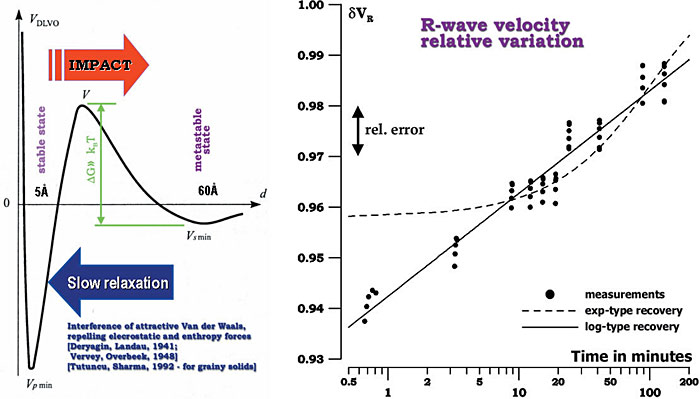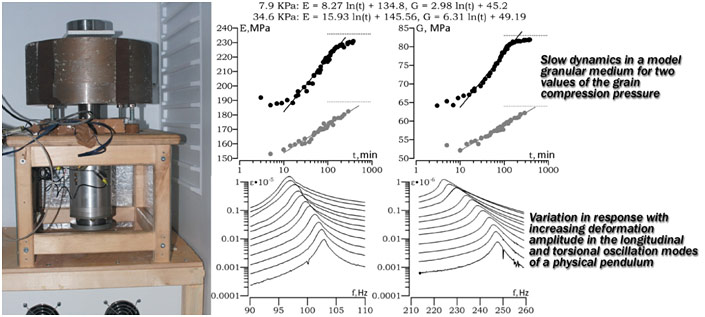Complex studies in the laboratory and in the Bezvodnoe test area
In 2006, in the Bezvodnoe test area we carried out an experiment on the in-situ observation of slow relaxation in a granular medium [1]. It was found that the relaxation of the granular medium after a strong impulse action has an unusual logarithmic dependence on time. In a simple thermodynamic model proposed in [1] the slowdown of the relaxation process was associated with the transition over an energy barrier of height significantly exceeding the energy of thermal fluctuations (Fig. 3.10, left).

Figure 3.10. The in-situ slow dynamics (Bezvodnoe, 2006). On the left is the DLVO potential with typical spatial scales (distance between grains).
Generalizations and comparisons of the proposed model with the data obtained by other researchers are presented in [2]. It is interesting to note that the relaxation process corresponds to very small scales of the order of first nanometers. For example, the data in Fig. 3.10 (right) correspond to a size of 2.5 nm. Analysis of the laboratory experiment data obtained by other researchers shows that the scale depends on the degree of homogeneity of the material and the presence of even a small amount of liquid [2]. Respective experiments on the slow dynamics observation under laboratory conditions are expected to be conducted using the method of acoustic spectroscopy, with an experimental facility for studying the properties of unconsolidated (loose) media.
In 2008 we proposed the scheme of a “physical pendulum” filled with the granular material under study where the oscillations are excited in the longitudinal and torsional modes. A feature of this measurement scheme which makes it different from the well-known method of a resonant column [3, 4] is the homogeneity of the deformations of the material in question and low excitation frequencies. In our opinion, this is important for a study of the amplitude dependences of the elastic modules and rheological properties of the granular media. Proximity of the frequency range to that used in the engineering seismic survey permits a comparative analysis of the field and laboratory data. The preliminary data available at the moment show good prospects for the proposed method of research. In the experimental studies, we used the equipment and processing techniques which were developed for solving the problems of resonance spectroscopy. Exterior view of the experimental setup is shown in Fig. 3.11 on the left. The pendulum, whose elasticity element is a polystyrene container filled up with a granular material, is placed in a thermostat. The temperature inside the thermostat is kept constant with an accuracy of approximately 0.005 C. This ensures long-term stability of the pressure inside the container at a level of ± 65 Pa. Preliminary experimental results on the observation of slow dynamics and on the study of acoustic nonlinearity of the packing of glass beads of the same size are shown in Fig. 3.11 on the right. The experimental setup, method of measurement, analysis of its features, calibration procedures, and preliminary results, including those represented in Fig. 3.11, are described in [5].

Figure 3.11. Exterior view of the experimental setup for a study of granular media under laboratory conditions (on the left) and preliminary experimental results (on the right).
The pendulum method is proposed for a joint analysis of the results obtained in a laboratory experiment with the soil samples taken from the Bezvodnoe test area and a field experiment on profiling with the use of Rayleigh waves. Such a comparison gives a better understanding of the mechanisms responsible for the observed variations in the shear wave velocity and the Poisson ratio. This enhances the information capacity of the method of remote diagnostics.
References to Section 3
1. Averbakh V, Lebedev A, Maryshev A, Talanov V (2009) Observation of slow dynamics effects in nonconsolidated media under in situ conditions. Acoustical Physics 55(2): 208–215.
2. Ostrovsky L, Lebedev A (2012) Nonlinear dynamical processes in media with relaxation. In: The 19th International Symposium on Nonlinear Acoustics. Waseda Univ., Tokyo.
3. Voznesensky E (1997) The Behavior of Soils under Dynamic Loads [in Russian]. Moscow State Univ., Moscow.
4. Pavlenko O (2009) Seismic waves in soil layers: nonlinear soil behavior in recent strong earthquakes. Scientific World, Moscow.
5. Averbakh V, Lebedev A, Manakov S, Bredikhin V (2013) A new method for acoustic characterization of particulate materials: preliminary results. Radiophysics and Quantum Electronics 56(3): 135–156.





